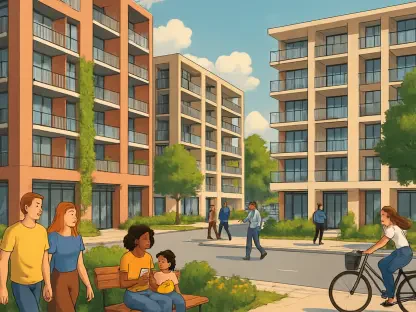The real estate market in 2025 presents an intricate blend of opportunities and barriers, as stakeholders strive to make sense of fluctuating trends and shifting priorities. This dynamic landscape has left many pondering the unpredictable patterns that define the housing sector today. Whether it’s about stabilizing demand amidst fluctuating mortgage rates or adapting to an evolving buyer demographic, the market remains complex. Despite increased challenges, real estate offers a range of opportunities for those who are strategic and well-prepared. A deeper understanding of current trends and forecasts can equip investors, buyers, and sellers with the knowledge they need to navigate these complexities. As the market continues to evolve, stakeholders must adapt to changes in inventory, interest rates, and buyer preferences. Staying informed is crucial for understanding critical elements that will determine success in real estate during this period.
1. Housing Market Shifts and Projections
The housing market has undergone significant transformations, compelling both buyers and sellers to reconsider their strategies. Home valuations, influenced by inventory levels and fluctuating mortgage rates, present unique challenges and opportunities for various market participants.
While surges in property valuations were noted a few years ago, current prices are experiencing minor readjustments rather than substantial downturns. Analysts suggest these adjustments result from several convergent factors, including steady demand in urban locations and limited housing availability. Economic shifts have made it challenging for significant price decreases to occur, while steady population growth continues to drive demand. However, potential buyers should prepare for only marginal changes in pricing, thus aligning their expectations accordingly. Contributors to ongoing property value trends include limited housing supply and increasing construction costs. Thus, while affordability constraints persist, the sustained demand in prominent areas will likely maintain a balance in pricing fluctuations.
Market activity occasionally stalls due to various factors impacting buyer confidence and seller preparedness, leading to a temporary freeze in transactions. This has been especially evident during fluctuating economic conditions, which provoke caution among stakeholders. Such instances affect transactional growth, requiring businesses dependent on real estate to innovate to maintain competitiveness. Real estate firms can seek alternative avenues to manage operations during market pauses by harnessing technology and employing innovative real estate solutions. Additionally, encouraging sellers to align their property prices with current market trends can increase activity and transactions. The gradual normalization of mortgage costs could potentially reignite buyer interest, further facilitating market recovery.
2. Motivating Factors for the Current Real Estate Climate
A combination of rising interest rates and constrained housing inventory plays a pivotal role in shaping today’s housing market strategies. This environment presses both buyers and sellers into making discerning choices amidst the ever-evolving backdrop of the real estate milieu.
The impact of mortgage rates is undeniable, as even small fluctuations can decisively reshape purchasing power and housing demand. Prospective buyers face constraints due to increased borrowing costs, which limit affordability and slow down market activities. These periods of higher rates often lead to a retrenchment in buyer interest and a deceleration in sales. Coupled with a restricted housing supply, elevated mortgage costs challenge the overall market by maintaining higher property values. Consequently, those involved in real estate operations must adjust to more cautious buyer behavior and adopt suitable strategies during such times. The ways mortgage rates fluctuate and their widespread influence underscore the complexity of forecasting the housing sector in today’s climate.
Inventory constraints are pressing on existing supplies, as an increasing number of homeowners show reluctance to sell due to advantages they hold from past, lower interest rates. This results in buyers competing over the limited properties available, intensifying the dynamics of the market. Hurdles to builders, including high material expenses and labor deficiencies, exacerbate these inventory shortages, further complicating residential availability. Business owners venturing into real estate during these times should brace for decreased opportunities on the residential construction and resale fronts. This environment requires a recalibrated approach to investment as one navigates the complexities of supply, demand, and rate fluctuations.
3. Residential Real Estate Developments
Current residential real estate market trends reflect the evolving preferences and strategies of both homebuyers and developers, particularly in their pursuit of opportunities and adaptation to fluctuating dynamics. Understanding these trends is crucial as they drive the ever-changing landscape of real estate.
In terms of existing-home sales, the pace at which properties are changing hands might appear subdued due to several factors. A persistent scarcity in inventory continues to constrain potential transactions, even as mortgage rates present stabilizing trends. Many sellers prefer postponing their listings due to uncertainties or conditions perceived as unfavorable for selling. The combination of increased borrowing expenses and limited choices also deters potential homebuyers. Yet, certain markets maintain undiminished demand, driven by shifts in demographics and workplace customs, particularly remote work trends. Such circumstances indicate that while existing-home sales may experience temporary lulls, the underpinning demand remains robust in specific areas.
On the flip side, new home sales may see promising prospects as various developments indicate renewed activity. Demand for new constructions tends to rise as buyers seek alternatives in tighter inventories. Additionally, builders themselves are addressing affordability by focusing on efficient designs and smaller properties, keeping pace with shifting buyer preferences. Luxury segments continue to thrive as premium developers emphasize craftsmanship and alignment with sustainability. Consequently, diminishing delays in construction materials have allowed for more realistic delivery expectations.
4. Economic Considerations and Their Effects on the Market
The intersection of economic trends and real estate dynamics can introduce challenges for stakeholders gearing up for market changes. Monitoring economic indicators and adjusting strategies will be crucial for navigating these influences effectively.
Homeownership benefits from rising equity, which serves as a safety net for property owners facing financial hardships. Elevated home equity levels furnish homeowners with options, such as selling properties to avoid defaults, contributing to steadier economic conditions. The U.S. saw unprecedented home equity levels recently, insulating many against economic fluctuations. While this trend provides security during downturns, there’s still a risk of foreclosures if market predictions falter or if mortgage rates maintain an upward trajectory. Regional disparities may exacerbate risks in slower-growing markets, where weaker job prospects or price growth might hinder buyers’ financial resilience. For real estate professionals, monitoring these variations is imperative to understanding the nuances of different markets and adapting their strategies accordingly.
Construction and confidence levels are crucial dynamics dictating current real estate energies, as builders grapple with economic uncertainties and operational challenges. Rising costs of raw materials and persistent labor shortages impact builder optimism, slowing new project initiations despite pressing demand. Mortgage rates and buyer affordability emerge as essential determinants in builder sentiment, impacting whether construction activities gain or lose momentum. Steadiness in economic conditions could renew interest in homebuilding and foster confidence. Recent observations hint at a gradual recovery in summit levels, signaling optimism for sustained activity as economic factors stabilize.
5. Expert Recommendations for Navigating Today’s Market
Effectively maneuvering the current real estate market requires industry participants to remain vigilant and anticipate changes. By adopting these insights, buyers and sellers can better position themselves amidst evolving market landscapes.
For buyers, strategic planning and a robust understanding of market trends can ease entry into the real estate market. Prospective buyers should monitor fluctuations in mortgage rates closely, as minor adjustments have significant impacts on purchasing power and associated costs. Establishing financial readiness is critical, and factors like a strong credit score and saving for a substantial down payment can offer advantages in securing favorable loan conditions. Analyzing market trends within specific locations provides valuable insights, as property values may differ depending on regional dynamics. Given potential inventory hurdles, staying alert for new listings and reacting quickly remains essential. Additionally, seeking counsel from professionals familiar with specific locales further enhances decision-making capabilities.
Sellers must prepare for a competitive and shifting environment, leveraging new strategies to successfully close property transactions. Accurately pricing properties involves comprehensive market research and a realistic assessment of local values. Promoting energy-efficient features aligns with growing preferences for sustainability, while effective home staging boosts property appeal. Using digital marketing platforms with high-quality visuals can expand reach and captivate potential buyers. Sellers need adaptability, adjusting to fluctuating mortgage rates and their impact on pricing strategies. Prioritizing necessary repairs before listing and maintaining impartiality during valuations facilitates optimal outcomes. Patience may be required to secure suitable offers, as active listing management and adjusted marketing tactics sustain presence during slower periods.
Strategic Adaptation in Real Estate’s Changing Landscape
The housing market has seen significant shifts, causing buyers and sellers to rethink their approaches. Home values, shaped by fluctuating inventory levels and mortgage rates, present unique hurdles and possibilities for those involved in the market. While home prices skyrocketed a few years back, they are now making slight shifts rather than drastic drops. Experts attribute these changes to a mix of steady urban demand and limited housing supply. Economic trends challenge the likelihood of large price cuts, with population growth continuing to boost demand. Prospective buyers should brace for only small price variations, managing expectations accordingly. Factors like limited housing supply and rising construction expenses contribute to current property value trends. Though affordability remains a concern, robust demand in key areas may stabilize pricing shifts.
Occasionally, market dynamics slow due to elements affecting buyer assurance and seller readiness, temporarily halting transactions. This pattern is particularly noticeable during uncertain economic times, prompting caution among market players. Such pauses impact transaction growth, pushing real estate-dependent businesses to innovate for competitiveness. Companies can explore alternative strategies during market lulls, utilizing technology and creative real estate solutions. Aligning property pricing with market trends can boost transactions, while gradual mortgage rate stabilization may reignite buyer interest, aiding market recovery further.









